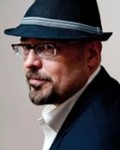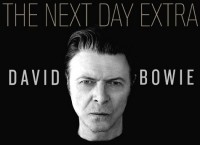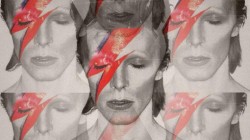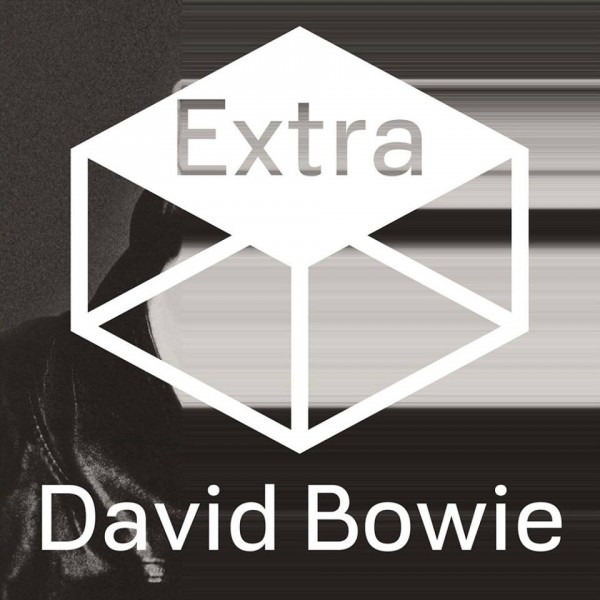 BY STEVE VOLK RESIDENT BOWIE SCHOLAR After nearly a decade of near total silence, the legacy of heart trouble that ended his 2004 world tour, the single arrived with no greater fanfare than someone, somewhere, clicking “publish” on a new posting to David Bowie’s web site.. Bowie sang. “Where are we now?” The song bled from millions of computers, languid and beautiful, as Bowie reappeared, suddenly, in a melancholy video supporting a mesmerizing single, on his 66th birthday. And fans, critics and entertainment wags wondered at the return of the Greta Garbo of rock n’ roll.
BY STEVE VOLK RESIDENT BOWIE SCHOLAR After nearly a decade of near total silence, the legacy of heart trouble that ended his 2004 world tour, the single arrived with no greater fanfare than someone, somewhere, clicking “publish” on a new posting to David Bowie’s web site.. Bowie sang. “Where are we now?” The song bled from millions of computers, languid and beautiful, as Bowie reappeared, suddenly, in a melancholy video supporting a mesmerizing single, on his 66th birthday. And fans, critics and entertainment wags wondered at the return of the Greta Garbo of rock n’ roll.
After such a long time away, why this song to reintroduce himself? The references to German place-names Bowie frequented during his Berlin recording spree/rehab — “a man lost in time, near KaDaWe” — suggested a personal touchstone. But the broadness of the sentiment, the existential angst of the question, engaged the wider world: Now that the wall is down,  and more people are freer than ever, and we can carry entire libraries of music and literature in our pockets; now that governments can and do monitor our communications so easily, and we are less free than ever; and the environment—political, meteorological— seems bent on killing us all; now that we are pitched so precariously between technological mastery and death, er, where—vocal tremolo—is that?
and more people are freer than ever, and we can carry entire libraries of music and literature in our pockets; now that governments can and do monitor our communications so easily, and we are less free than ever; and the environment—political, meteorological— seems bent on killing us all; now that we are pitched so precariously between technological mastery and death, er, where—vocal tremolo—is that?
As it turned out, “Where Are We Now?” comprised the perfect introduction to the entire album that followed. But in the immediate aftermath of the surprise, there was just one thing we knew: We were listening to a new David Bowie song, off of a new David Bowie album. And as forms of solace go, we could do worse. Now, The Next Day is all dressed up as a three disc set, including the original 14-song CD, the four music videos shot to promote it, and a 10-track collection of “extras” that are, happily, strong enough to stand on their own.
DISC ONE
The Next Day
There were some, among the rock crit set, who wondered if Bowie’s new work was being overrated out of sheer relief that the man was back. But more than a half-year after its release, Bowie’s comeback actually sounds better than it did at the time. “Here I am, not quite dying!” Bowie chants on the album’s first, clamorous chorus, blowing away, in one snarl, rumors he was terminally ill. The template is set. The Next Day, no matter how varied in sound or subject matter, acts as a kind of kaleidoscope, constructing and deconstructing the personal and universal, the long ago and the now.
As statements of purpose go, the bouncing, grinding title track, which opens the album, is a corker. “They  just can’t get enough of that doomsday song,” Bowie sneers. Ostensibly, he is singing from the point of view of a medieval tyrant, about to be overthrown by a mob thirsty to see him suffer, bleed and die. But it’s impossible not to read the line, too, as a reference to “Rock n’ Roll Suicide,” the track that heralded Ziggy Stardust’s demise, before a crowd that adored him to death.
just can’t get enough of that doomsday song,” Bowie sneers. Ostensibly, he is singing from the point of view of a medieval tyrant, about to be overthrown by a mob thirsty to see him suffer, bleed and die. But it’s impossible not to read the line, too, as a reference to “Rock n’ Roll Suicide,” the track that heralded Ziggy Stardust’s demise, before a crowd that adored him to death.
References to Bowie’s life and back catalogue crop up everywhere, like the Easter Eggs in a video game or the literary allusions of Ulysses. (Disparate analogies. But Bowie’s art has always been about slamming low and high culture together.) Yet there is no sense that Bowie is navel-gazing. References to mortality are everywhere — his and ours’ — but Bowie sounds as engaged with the world around him as ever. Some of it is the subject matter, from the vampyric nature of celebrity to schoolhouse massacres and the horrors of war. But, happily, it’s also there in the songs—a gushingly melodic Bowie—his silence over, the dam burst, in the form of 14 songs that rush by in less than an hour.
Even divorced from its vital role in Bowie’s comeback narrative, “Where Are We Now?” is a haunting elegy—the doomed romanticism of youth meeting the wisdom of age. The anti-war tracks are by turns tuneful (“I’d Rather Be High”) and terrifying “How Does the Grass Grow?” Answer: “Blood! Blood! Blood!”). The effect is less comeback than career highlight. In all of rock and roll, only Bryan Ferry or Morrissey would even attempt to put across a ballad so grand and dramatic as “You Feel So Lonely You Could Die.” But neither of them would ever have concocted this — using the aural template of the show-stopping love song as the setting for a cold war thriller. Bowie musters as much passion as Lorraine Ellison, bellowing “Stay with me, baby!” But instead of hoping for a love to last, Bowie’s protagonist longs for the immediate death of an enemy, some unnamed double agent, who betrayed him. “I can see you falling, hear you moaning, in your room,” Bowie sings, tortured. “Oh, see if I care. Oh please, please make it soon!”
The musical styles Bowie employs, from burlesque bump and grind (“Dirty Boys”) to dense jungle (“If You Can See Me”) are so varied the album can be listened to as a compilation of singles. But the man “lost in time” that Bowie conjures on “Where Are We Now?,” is in a sense, all over the album: in medieval Europe watching that tyrant get his; on a stage in  1973, killing off Ziggy Stardust; in a ’60s club, just after midnight in the Village; dancing out in space; at the scenes of every World War. And wherever we are, now, the story is always the same: Redemptive moments are found—in love, family, a three-minute pop song—then gone, pointillist portraits of lives lived, snuffed, and consigned to stardust. In his early days, Bowie, like any rock star, came on like he was out to save the world. Those days are long gone, flushed away with youth. But what he’s done here is describe the world as he found it—a far more realistic, and its way more useful, gift.
1973, killing off Ziggy Stardust; in a ’60s club, just after midnight in the Village; dancing out in space; at the scenes of every World War. And wherever we are, now, the story is always the same: Redemptive moments are found—in love, family, a three-minute pop song—then gone, pointillist portraits of lives lived, snuffed, and consigned to stardust. In his early days, Bowie, like any rock star, came on like he was out to save the world. Those days are long gone, flushed away with youth. But what he’s done here is describe the world as he found it—a far more realistic, and its way more useful, gift.
DISC 2
The Extras
“Atomica”
A rip-snorting, floor-stomping rock song, with new wave overtones and immediate earworm status. “I’m just a rock star stabbing away,” Bowie sings at the outset. “I’ll take the lead for another day.” As statements of intent go, it’s a doozy: humble (“just…stabbing away”), braggadocios (“I’ll take the lead…”) self-referential and temporal (The Next Day/”another day”). The riff is glammy, the delivery souped up, like Elastica tearing apart an art school. Single material.
“Love Is Lost (Hello to Steve Reich by James Murphy for the DFA) Remix”
The mastermind of LCD Soundsystem did a complete rethink of this track from The Next Day, replacing the bluesy electronica of Bowie’s original backing track with an avant-garde dance number and expanding it from four minutes to a perfect 10. The intro alone is a wonder—hands, clapping out of time, slowly fall into a danceable rhythm (a nod to the Steve Reich mentioned in the subtitle). Murphy also isolates Bowie’s multi-tracked vocals, eschewing harmony for the sound of a lonely man, singing.
“Plan”
A spiky, menacing instrumental that unwinds like live wire.
“The Informer”
A doo-woppy “big number” that mines the same territory as “You Feel So Lonely… ” —sonically and lyrically. The protagonist is a man who has just been leveraged into playing informer  to—well, to whom, exactly? The police? The nation state? The whole thing, verses included, soars like a chorus. And Bowie’s multi-tracked backing vocals are among his finest, erecting a big wall of boomy “waaas” as consolation against a coming lifetime of sadness and regret. “And I still don’t know what we were looking for,” he sings, “but it wasn’t you.”
to—well, to whom, exactly? The police? The nation state? The whole thing, verses included, soars like a chorus. And Bowie’s multi-tracked backing vocals are among his finest, erecting a big wall of boomy “waaas” as consolation against a coming lifetime of sadness and regret. “And I still don’t know what we were looking for,” he sings, “but it wasn’t you.”
“I’d Rather Be High (Venetian Remix)”
The title promises little—the sort of filler that adorns digital releases and old 12-inches. But the song was one of the (many) highlights from The Next Day and this version, which varies from the original to greater degree as it progresses, better conveys a sense of mourning
“Like a Rocket Man”
An Elton John ripoff? (Or fuck off?) No. An outer space song? An ode to drug addiction? Yes. As pop songs go, it’s also four aces. Imagine Buddy Holly, still alive, recording ’60s-style chiming pop.
“Born In a UFO”
Rocky Horror rock and roll. Interstellar travel, fueled by power chords. The girl of your dreams, unloaded from an alien craft. “Like outer space!” Bowie hollers, sounding as amazed and joyful as he has in all his recorded years.
“I’ll Take You There”
Sad to see a track so fine emerge only as part of an extras bundle. The riff bristles with the energy of a man starting life in a new land. “Who will I become in the USA?” Bowie  sings. The sound of life, blasting off into a brave new world.
sings. The sound of life, blasting off into a brave new world.
“God Bless The Girl”
The gently chiming guitars beg for a Bo Diddly-esque beat, which arrives in its Sunday best, pushing the song toward a churchy, gospel rave-up about, near as I can tell, the horrors of sex trafficking. “I don’t wanna hurt you,” Bowie sings. “Just wanna have some fun.” By turns warm and chilling.
“So She”
A lush, mid-tempo coda, in which the writer, having visited a hundred distant shores, finally finds a restful home.
DISC 3
The Videos
“The Stars Are Out Tonight,” hits all the right notes. Bowie and guest star Tilda Swinton capture the creeping dread of cozy domestic life—an old, wedded couple, sodden, and couch bound by the stars they see on television. “The Next Day” is (literally) bloody great blasphemy, with Marion Cotillard and Gary Oldman joining Bowie in a plot about prostitutes at the Vatican. And “Valentine’s Day” is one of the most intense performances Bowie has ever committed to film, hoisting his guitar in poses that mock the NRA. But the real masterwork here is “Where Are We Now?”
Fully aware of the rumors surrounding his health, post-heart attack, Bowie appears first in weathered, withered form, his aging face projected atop a puppet, lip-syncing the words to  his new song, his voice tremulous and vulnerable. Only after the song takes flight, a full half way through its stirring conclusion, does Bowie appear—without masks, make-up or magic, a man in the t-shirt and jeans he happened to put on that day, standing about in an artist’s studio. The suggestion isn’t just that he has been here and healthy the whole while we’ve missed him and speculated on his mortality. The suggestion is that this is who he’s always been.
his new song, his voice tremulous and vulnerable. Only after the song takes flight, a full half way through its stirring conclusion, does Bowie appear—without masks, make-up or magic, a man in the t-shirt and jeans he happened to put on that day, standing about in an artist’s studio. The suggestion isn’t just that he has been here and healthy the whole while we’ve missed him and speculated on his mortality. The suggestion is that this is who he’s always been.
***
DAVID BOWIE: 1980 Floorshow
EDITOR’S NOTE: The first minute is garbled, but it’s smooth sailing after that.
5YEARS.COM: The 1980 Floor Show (a pun on the song “1984” – 19-Eighty-Floor) was the first appearance of David Bowie since his much publicised retirement on 3 July 1973 at the Hammersmith Odeon. It was also to be his last appearance as “Ziggy Stardust”. The show itself was a spectacular stage production that was filmed over 3 days, mostly at The Marquee Club, Soho, London for the American NBC TV late night show The Midnight Special. […] The first day of the 1980 Floor Show was reserved for filming at a studio – while the actual filming at the Marquee was carried out on the 19th & 20th October. Bowie personally chose the setting for the show, after first considering the possibility of a full-scale live concert (rejected by the NBC as too expensive).
“There were a lot of clubs to go to in the Soho scene in the 60’s but The Marquee was top of the list, because  musicians did hang out there, pretending to talk business and picking up gigs – but picking up girls mostly,” said Bowie. “One of my keenest memories of The Marquee in the ’60’s was having a permanent erection because there were so many fantastic looking girls in there, it was all tourists, especially in summer, all flocking to London to get an R&B star. My final performance of Ziggy Stardust was at The Marquee. I wanted to go back there because I had so many good memories over the years. We changed the place completely and for 3 days we filmed what became ‘The 1980 Floor Show’. I had The Troggs on with me and then got Marianne Faithfull to duet with me on a version of Sonny & Cher’s ‘I Got You Babe’. I dressed Marianne in a nun’s habit with the back cut out and I dressed as the Angel of Death!”
musicians did hang out there, pretending to talk business and picking up gigs – but picking up girls mostly,” said Bowie. “One of my keenest memories of The Marquee in the ’60’s was having a permanent erection because there were so many fantastic looking girls in there, it was all tourists, especially in summer, all flocking to London to get an R&B star. My final performance of Ziggy Stardust was at The Marquee. I wanted to go back there because I had so many good memories over the years. We changed the place completely and for 3 days we filmed what became ‘The 1980 Floor Show’. I had The Troggs on with me and then got Marianne Faithfull to duet with me on a version of Sonny & Cher’s ‘I Got You Babe’. I dressed Marianne in a nun’s habit with the back cut out and I dressed as the Angel of Death!”
The Marquee Club itself was a famous London performance venue where Bowie had watched many R & B giants of the 1960s perform and had himself played in the 1960s as a support act. It quickly outgrew its first location, on Oxford Street, and moved to 90 Wardour Street in 1964, where the Rolling Stones, Yardbirds, The Who, Small Faces, Spencer Davis Group and every other important band was showcased, along with Jimi Hendrix, the Byrds, the Lovin’ Spoonful and other visiting American bands. It no longer exists today, having been demolished. While illustrious as a venue, the Marquee in 1973 was small, cramped and shabby and this necessitated a number of enforced changes for the benefit of television. Much to the horror of the Marquee staff and club owner Jack Barrie, the stage and back-drop were completely rebuilt and the walls and ceilings repainted black. MORE

